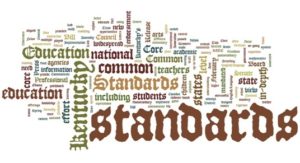To ensure the proper use of standards in guiding curriculum, instruction, and ultimately student learning, “standards” should be defined in a way that makes sense when communicated to the public, teachers, students, and school systems. Although categorized in ways including “academic,” “content,” and “performance,” our focus should be on the classroom and students.

Setting content standards does NOT ENSURE an increase in student achievement. EVIDENCE repeatedly points to standardization having the opposite effect — it narrows what is taught to what is tested especially where resources are limited. Image credit: Big Education Ape: May 13, 2012
“Learning standards” clarify what knowledge and skills we have determined are essential for students to obtain. When a specific standard is to be met at a specific grade level or point in time, it is called benchmarked. This is similar to understanding developmental milestones for a baby – some meet them sooner, some later than the average. A learning progression is the sequence we expect to be taught and learned.
The basic idea is to make sure that all students are learning age-appropriate material (knowledge and skills that are neither too advanced nor too rudimentary), and that teachers are sequencing learning effectively to avoid the inadvertent repetition of material or to leave gaps in what is deemed an essential skill or fundamental knowledge.
We have come to expect “standards” to be used to guide the development of a standards-referenced local curriculum. As standards filter down to the classroom, they can be conveyed to students as “learning objectives.” In many cases, learning objectives are the interim academic goals that teachers establish for students who are working toward meeting more comprehensive learning standards.
The distinction between standards-referenced and standard-based is confusing for both educators and the public—because the terms are sometimes used interchangeably and because the distinction between the two is subtle and nuanced. Standards-referenced refers to inputs (what is taught is “referenced” to or derived from learning standards). Standards-based is focused on outputs (what is learned as defined by meeting a fixed “proficiency” level). Understanding Standards
Recommendation from Robert J. Marzano, 1996, Practical Assessment, Research & Evaluation:
Write grade level benchmarks for grades K-8 [providing teachers with a great deal of ‘itemized’ guidance regarding a clear hierarchy of knowledge and skills that is grade level specific]. Write course descriptions for high school [where courses are the main organizational structure].
This approach allows elementary schools and high schools to describe desired educational accomplishments in terms relevant to the hierarchical structure of knowledge and skills at each level. However, education officials must be certain that the high school course descriptions contain explicit standards.
“…education policy makers must be sure that they base their decisions about standards upon the needs of the communities which they serve.” Robert J. Marzano and John S. Kendall, A Tool for Constructing Local Standards, The McREL Database

Pingback: Outcome-Based Education Reform | The Crucial Voice of the People
Pingback: The Common Core Conspiracy - The Crucial VoiceThe Crucial Voice
Pingback: Stuck in the Muck: Trapped in Outcome-Based Reforms - The Crucial Voice of the PeopleThe Crucial Voice of the People
Pingback: Accountability Where It Matters Most | The Crucial Voice of the PeopleThe Crucial Voice of the People
Pingback: Do I Understand ESEA? | The Crucial Voice of the PeopleThe Crucial Voice of the People